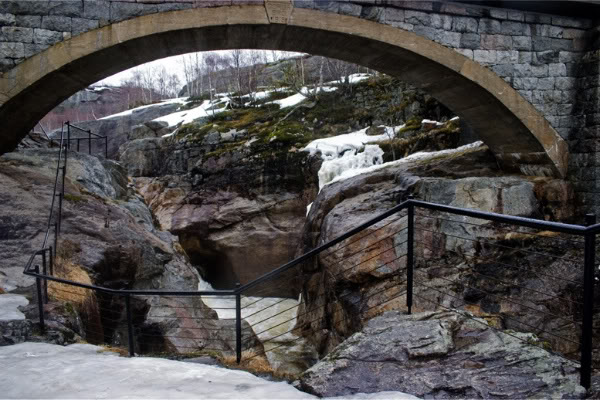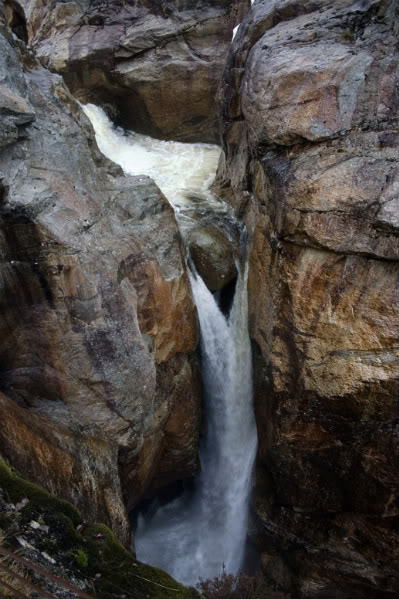Short description
Dorgefossen is a spectacular waterfall in Sirdal between Tonstad and Svartevatn along the Rv468. Due to the regulation of the Sira and Kvina rivers the amount of water is greatly reduced for most of the year. However, this offers a good view on the canyon the falling water has created.
Location information
The coordinates refer to the parking area. There is a path down to a fenced off area that gives a great view onto the waterfall and the rocks. On the other side of the road you can find a picnic area, toilets and information boards with hiking paths and other information for this part of Sirdal.
Introduction
The waterfalls in Norway are majestic, powerful, and abundant. This is because Norway’s geography features high plateaus where abundant snow can accumulate over the winter months and fjords into which the water is plunging especially in spring time. There are many waterfalls which are higher or have a greater water discharge.
Dorgefossen is special because you have an undisturbed and spectacular view down the fall from a secure platform in order to observe how the erosional power of the water has created this fall and has carved a vertical canyon into the rock.

Origin of waterfalls
Dorgefossen is fed by Øysteinevja lake. The pounding of the water at the base of the fall is powerful enough to erode the local hard granite away and leave a deep gorge, especially when the water contains great amounts of suspended sediment. However, erosion also happens at the top where the water starts to fall down and over time this gradient will become gentler while the top moves further upstream. The time it takes to erode a river bed to a gentle slope and then into a water fall depends on the volume of water flowing over the drop, the amount of sediment that grinds into the river bed, and the hardness of the rock over which the river flows.
Waterfalls are created by four main processes:
- recent uplift or down-dropping of parts of the Earth’s crust. To follow its old course a river will fall down from the uplifted area.
- diversion of a river when a pre-existing channel is blocked.
- differential erosion of valleys, especially from large glaciers and smaller tributaries that erode less of the rock away.
- increased erosion along existing faults.
Local geology
Dorgefossen cuts into the local granite. Granite is an intrusic magmatic rock very common in Rogaland. As the molten magma didn't reach the surface the cooling occured very slowly and resulted in much larger crystals than when lava cools at the surface.
Granites are usually very hard and resistant to weathering, and lack any internal structures like layering. Layered geology would create a different-looking waterfall. If a resistant layer is on top of a softer rock then the latter would be washed out from underneath the competent layer forming a small cave behind the fall until the hard layer eventually breaks off. As the granite at Dorgefossen is so hard and uniform the walls lack substantial caves behind the curtain of water. Still the water is strong enough to create several small plunge pools.
So many different falls
Waterfalls can be classified on the amount of water discharge and their geometry. The water volume classification is more scientific and based on how much water is present during the vertical drop. For this you'd need to collect streamflow data over a year. Secondly, you need to determine the vertical height of the fall and calculate how long one droplet of water needs to fall down. This gets more complicated when the fall has a strange shape, does not have a straight fall or the discharge varies greatly thoughout the year. This is the more precise classification but it’s far too complicated for a bit of fun.
A geometrical classification is quicker and requires no calculations, nor measuring instruments. However, this classification is less precise as it’s based on interpretation, and some falls can fall into more than one category. You can have a look at the different types of waterfalls at this EarthCache.
Other visiting information
Dorgefossen is most spectacular in spring time when a lot of melting water is discharged into the surrounding lakes and river, however a revisit during other parts of the year might be interesting as well to see the difference the regulation by the hydropower stations make.
While the edge of the fall is blocked off by fences parents should still take good care of their children, especially in winter and spring when the small slope down to the viewing platform might be very icy.

Logging this earthcache
You may log the Dorgefossen earthcache immediately after visiting, but we will require the answers to the questions below within a reasonable time frame.
| 1. |
Describe the rock you see around the water fall. You can look at the colours, crystal size or distribution of crystals. |
| |
| 2. |
What type of waterfall is this? Either describe in your own words or visit the link in the description above for some examples. |
| |
| 3. |
What influence do you think has the restriction of the water flow on the further evolution of Dorgefossen? |
| |
| 4. |
What process might have created Dorgefossen at that location? |
| |
Answers may be given in English, German or Dutch through our contact page and please tick the 'I want to send my email address along with this message', so we can reply directly to you.